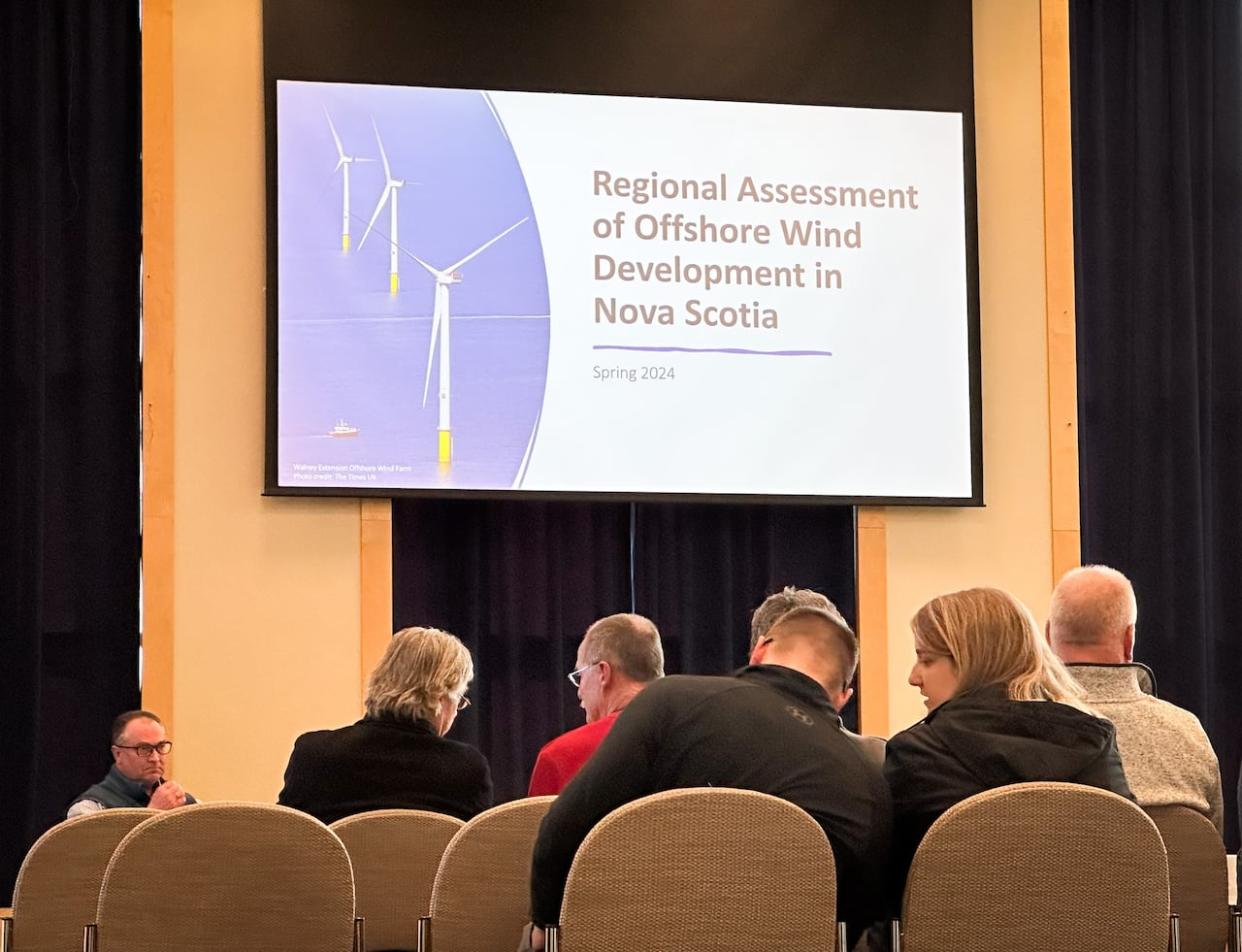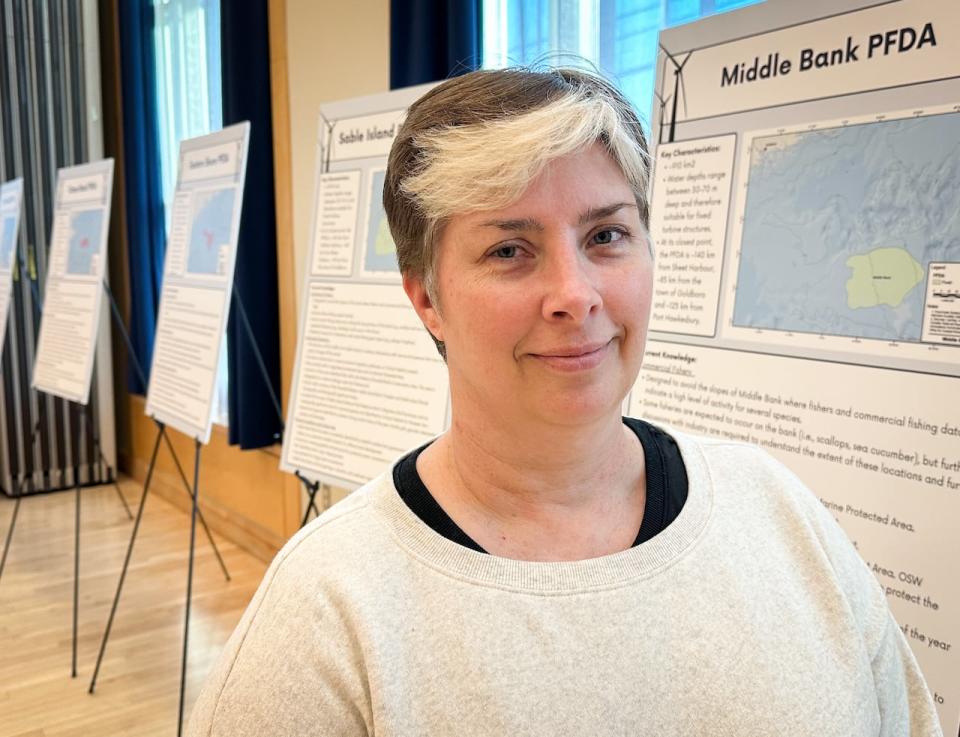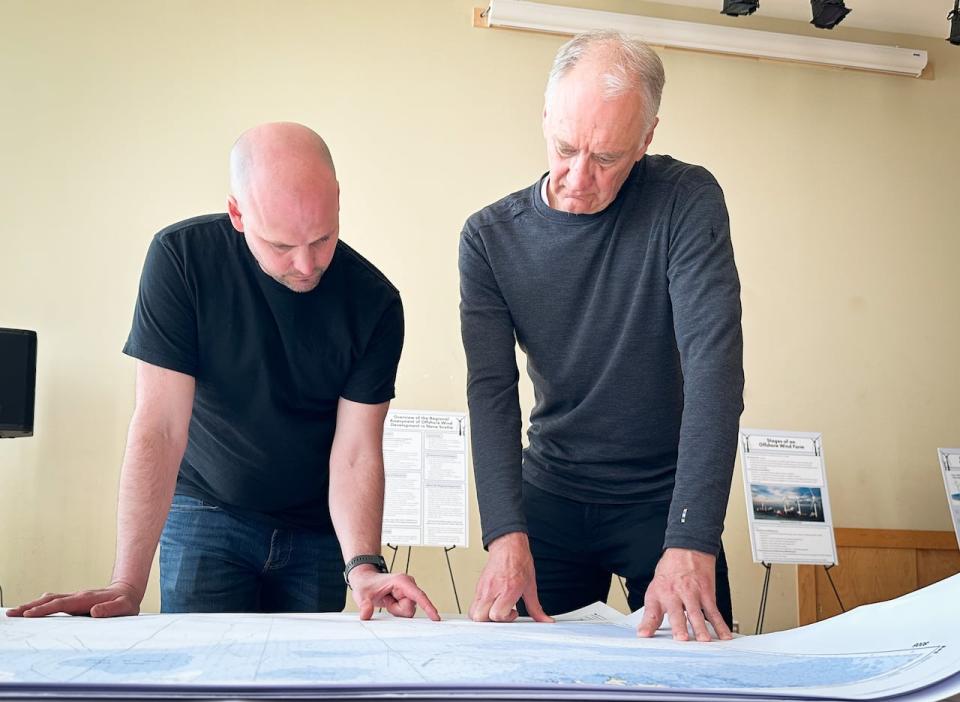Small group speaks up for fishery at offshore wind open house in Cape Breton

Only a few members of the fishing industry attended an open house Monday evening about the coming offshore wind industry in Nova Scotia.
But many of those who visited the Port Hawkesbury Civic Centre spoke in favour of the fishery, while also supporting the proposed new entry into renewable energies.
The independent committee for the regional assessment of offshore wind development is tasked with engaging the public and making recommendations to the provincial and federal governments on locations and regulations for offshore wind farms.
After an initial round of meetings, the committee has identified six possible locations for the giant turbines that can reach up to 300 metres high. Monday's meeting was the first in the second series of open houses.
About 15 people attended the meeting to see maps of the proposed locations, get information and provide feedback on the possible impacts.
Scott Samson, president of the Inverness South Fishermen's Association, said a proposed exclusion zone putting the wind turbines at least 25 kilometres off the coast around the entire province means most people in the fishing industry would not be affected.

Inverness South Fishermen's Association president Scott Samson says a proposed 25-kilometre exclusion zone around the Nova Scotia coast will protect the majority of fishers. (Tom Ayers/CBC)
"It would eliminate it for almost all inshore fishermen," he said. "Now the offshore fishermen, they may have some gear conflicts, but for the vast majority of fishers, it would not be a problem."
Samson also said none of the proposed offshore wind areas are in the Gulf of St. Lawrence and it wouldn't make sense to try to put any there.
"It seems like it's a congested area as far as vessel traffic, fishing and with the right whales situation, it's probably just a little too congested to stick windmills in."
Most of the other people in attendance were not in the fishery, but generally expressed interest in the burgeoning field of renewable energy.
Lois Landry, a retired educator from Isle Madame in Richmond County, said the committee has done a good job of engaging with the fishing industry.
"My concern really is are we balancing with a really important fisheries sector?" she said. "That's a really important thing to my part of the province."

Retired educator Lois Landry says she's not in the fishing industry, but was glad to hear the committee seemed to be listening to that industry's concerns. (Tom Ayers/CBC)
Landry said she was at some of the earlier meetings, which were attended by those in the fishing industry, and it seems like they are being heard.
"One of the things I heard loud and clear here is this committee really being really pleased with the engagement they've had with fishers," she said.
Bert Lewis, a retired educator from Port Hawkesbury, said it's important to protect the fishing industry, but Nova Scotia also needs new forms of renewable energy.
He said he is concerned about projections that construction on wind farms won't start until 2031 or later.
"Time is of the essence, in the sense that opportunities will pass us by if we don't get these regulations and the things in place so they can approve some projects and get them started," Lewis said.
"The timelines that they're quoting seem to be a little far out there and I wish there was a way of speeding it up."

Committee worker Andy Walter and committee co-chair Jim Wooder go over maps of proposed offshore wind farm locations in Nova Scotia. (Tom Ayers/CBC)
Jim Wooder, co-chair of the committee, said even though no fishers attended the first open house in the second round of public engagement, the committee has engaged extensively with individuals and fishing associations.
It has also established a strong relationship with the Nova Scotia Fisheries Alliance for Energy Engagement, which represents about 20 fishing associations, he said.
Those who showed up were interested and asked good questions, but the turnout for Monday's open house could have been better, Wooder said.
"It may be that some fishermen are getting information through their associations," he said.
"We recognize that people are busy and some of them are fishing. We tried to time this to avoid certain critical fishing seasons, but it's a challenge as well to do it at the right time."
Hoping for better turnout
Wooder said he hopes more will show up at Thursday's meeting in Sydney, which runs from 5 p.m. to 7:30 p.m. local time at the Simon Hotel.
The committee is also holding a session in Cheticamp on May 9 and more open houses will be scheduled on the mainland over the next couple of months.
People can also comment anytime online.
The committee plans to have a draft of its final report in September, which will be made available for public comment until November.
A final report is expected to go to the provincial and federal governments in January.
MORE TOP STORIES

